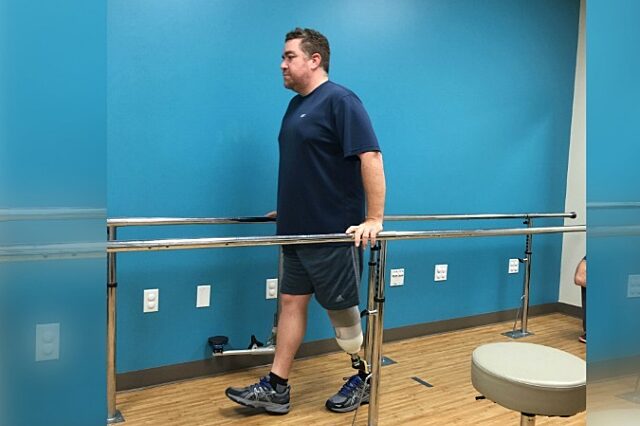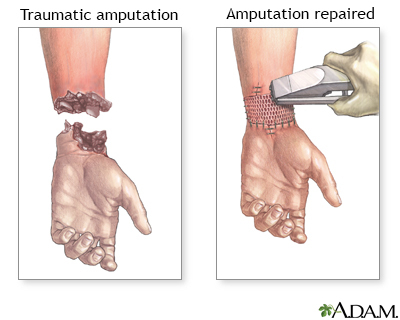Rehabilitation Helps Motorcyclist Live Life to the Fullest
Vaughn Thornton geared up for a leisurely Sunday afternoon ride in early 2016. “It was what people would call a chamber of commerce kind of day-80 degrees and…

Update your location to show providers, locations, and services closest to you.
Traumatic amputation is the loss of a body part, usually a finger, toe, arm, or leg, that occurs as the result of an accident or injury.
Loss of a body part
If an accident or trauma results in complete amputation (the body part is totally severed), the part sometimes can be reattached, often when proper care is taken of the severed part and stump, or residual limb.
In a partial amputation, some soft-tissue connection remains. Depending on how severe the injury is, the partially severed extremity may or may not be able to be reattached.
Complications often occur when a body part is amputated. The most important of these are bleeding, shock, and infection.
Long-term outcome for an amputee depends on early emergency and critical care management. A well-fitting and functional prosthesis and retraining can speed rehabilitation.
Traumatic amputations usually result from factory, farm, power tool accidents, or from motor vehicle accidents. Natural disasters, war, and terrorist attacks can also cause traumatic amputations.
Symptoms may include:
Steps to take:
If someone severs a limb, finger, toe, or other body part, you should call right away for emergency medical help.
Use safety equipment when using factory, farm, or power tools. Wear seat belts when driving a motor vehicle. Always use good judgment and observe appropriate safety precautions.

American Academy of Orthopaedic Surgeons website. Fingertip injuries and amputations. orthoinfo.aaos.org/en/diseases--conditions/fingertip-injuries-and-amputations. Reviewed May 2022. Accessed November 21, 2022.
Rose E. Management of amputations. In: Roberts JR, Custalow CB, Thomsen TW, eds. Roberts & Hedges' Clinical Procedures in Emergency Medicine and Acute Care. 7th ed. Philadelphia, PA: Elsevier; 2019:chap 47.
Switzer JA, Bovard RS, Quinn RH. Wilderness orthopedics. In: Auerbach PS, Cushing TA, Harris NS, eds. Auerbach's Wilderness Medicine. 7th ed. Philadelphia, PA: Elsevier; 2017:chap 22.
Our community and patient programs provide great value to patients, families and loved ones. People can find support, educational materials, expert consultants and more. In most instances, these programs are offered free of charge.
A support group for amputees who support one another, learn from each other and share stories and tips.
Vaughn Thornton geared up for a leisurely Sunday afternoon ride in early 2016. “It was what people would call a chamber of commerce kind of day-80 degrees and…
